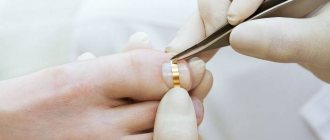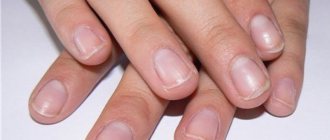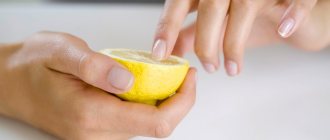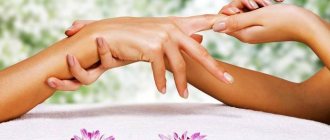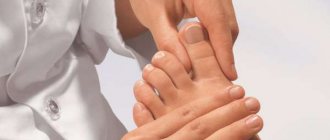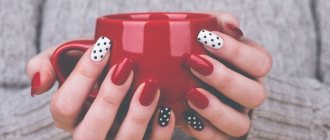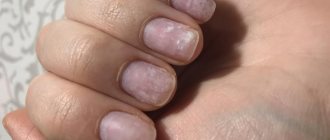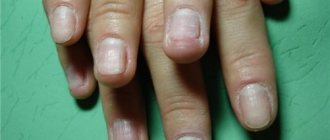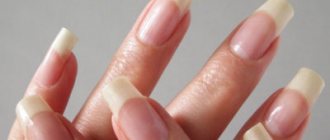Prevalence
Damage to the fingertips and nail bed occurs in people of all ages, with a peak incidence between 4 and 30 years of age. Depending on the mechanism of injury, there may be various types of damage. Most often they occur due to pinching, for example, by a door.
The nails protect the dorsal surface of the distal phalanges - the outer part of the fingertips. They help pick up small objects and have a cosmetic function, so it is important to know the signs of damage and be able to provide first aid.
Doctors classify nail injuries as follows:
- Acute ones arise as a result of an obvious damaging effect on the nail (impact, tearing) and are accompanied by ruptures of blood vessels. The fingertips are very sensitive, so due to severe pain a person may lose consciousness;
- chronic ones appear as a result of prolonged exposure to a damaging factor, for example, constantly wearing tight shoes or the slow but persistent progression of nail fungus. Their characteristic symptom is the formation of longitudinal and transverse cracks in the nail.
Approximately 50% of nail bed injuries requiring surgical intervention involve distal phalangeal fractures. If you have a finger injury, you must undergo an x-ray. ICD-10 damage code: S60.
More information about the structure of nails:
Nail structure and growth: what healthy nails and skin should look like, care rules
Causes
Most injuries result from the following::
- hit on the nail . This could be being hit with a hammer, being pinned by a door or drawer, being in a car accident, or being bitten by animals or people. This type of injury usually results in blood appearing under the nail, called a subungual hematoma. The symptoms of a blow are well known to everyone - sharp pain in the immediate area of injury, swelling and redness.
- cuts. They arise due to the careless use of knives, scissors, and sharp files. The nail plate may be damaged or torn off. Serious cuts (incised wounds) affect muscles, tendons, blood vessels, ligaments and nerves.
- inappropriate shoes. Regular injuries to the toenails caused by improperly fitting shoes can lead to deformation of the plate. In appearance, it resembles a fungal infection: the plates thicken or become discolored and then move away from the nail bed, causing cosmetic problems.
- habit of biting nails and cuticles . It is the main cause of acute paronychia - an infection in which bacteria get under the tissue on the side of the nail and cause swelling, irritation, and severe pain.
Lyudmila Sheveleva
Doctor, pharmacist
Ask a Question
It is only in everyday life that constantly biting off part of a nail is considered a bad habit. Doctors call it onychophagia - a mental disorder that most often occurs in childhood and is less common in adults.
Structure of nails
The nail is protected on all sides by rollers. The posterior layer is called proximal. It is connected to the nail by a thin film called eponychium. This skin brings the young nail to the surface, after which it is no longer needed. It also has another name - pterygium. When the film is not removed from the nail plate, it pulls the skin of the roller and can grow to the middle of the nail. This often leads to the appearance of tears when the hand moves sharply forward. It is removed during a manicure.
Under the nail is the nail plateau, or bed. It is rich in blood capillaries, so in case of any injury it is not easy to stop the bleeding. The nail matrix tissue continues here, which has a much smaller layer than under the cuticle. This determines the different growth rates of parts of the nail: on the surface of the nail, cells move towards the free edge three times slower than those that are in direct contact with the bed.
Types of injuries and symptoms
There are several types of injuries. They can be isolated - when there is only one type of damage. If two or more types are simultaneously observed on one finger, then such an injury is called combined.
The following types of damage may occur:
- a subungual hematoma appears due to the accumulation of blood under the plate . The mechanism of damage is a direct blow to the nail. The platinum itself remains intact, but the vessels under the nail are injured. Such damage is characterized by pain of varying degrees of intensity, a local increase in temperature, swelling, the appearance of red, and then bluish and black coloring of the nail;
- laceration occurs upon contact with a hard, blunt object that “catches” soft tissue. It has uneven edges, detachments and scalping of the skin are possible. A lacerated wound is complicated by bleeding, and somewhat less commonly, by damage to muscles, nerves and blood vessels;
- traumatic amputation - the nail is partially or completely torn off . Depending on the depth of the injury, crushed soft tissue and bone may be visible. Occurs when a finger gets caught in moving mechanisms, or when a large load falls on the hand or foot;
- nail detachment is the separation of the plate from the bed . Most often it appears as a result of injury or fungal infection. First, the top of the nail or its sides peel off. And then the defect moves to its base - the entire surface moves away from the nail bed;
- the fracture of the distal phalanx can be closed, i.e. invisible to the eye . It can occur when falling or hitting the phalanx with a heavy object. Fractures of the distal phalanges are extra-articular (longitudinal, transverse and comminuted) and intra-articular. Even if there is no noticeable deformation of the finger, an x-ray should be taken.
How does a fingernail and toenail work: description and diagram
The nail is located in the nail bed and lacks blood vessels and nerves.
On one side it goes into the root of the nail fissure, and on the other it ends with a free edge. The back and sides are limited by the nail folds (skin folds), and the place where they connect with the nail is called the nail sinuses. The rollers at the base are connected to the nail plate using the cuticle, which protects against infection. Nail growth is produced from the matrix. It turns into a round white spot - the lunula, and then into the nail bed. The following is a description of each part and a diagram.
Eponychium (cuticle)
The eponychium or cuticle protects the matrix and nail bed from dirt and infection . It is an overgrown continuation of the nail fold and consists of dead cells. In case of strong regrowth, it may crack, causing burrs to form. There is a risk that bacteria can enter living tissue through such cracks and inflammation can begin. It is very important to process the cuticle in a timely manner: push back, trim or remove with a manicure device.
Pterygium
Pterygium is a thin film adjacent to the nail and is the bottom layer of the cuticle. Performs a similar function of protecting against the penetration of bacteria, grows along with the nail and is almost invisible. During a manicure session, it is removed along with the cuticle.
Transverse groove
The appearance of transverse grooves may indicate mechanical damage. However, if they are excluded, then this may be a signal of significant dysfunction of the body. Furrows may appear when:
- problems with the gastrointestinal tract when enzyme synthesis is disrupted;
- poor blood filtration due to kidney disease;
- diseases of the cardiovascular system;
- disorders of the musculoskeletal system, if the furrows are accompanied by the appearance of small tubercles;
- fungal infection if there is itching and flaking of the skin.
Matrix
The matrix or root of the nail is the area of its formation. What shape and thickness the nail will be, as well as its density and growth, depend on the matrix. Its cells contain blood vessels and nerve endings.
Each person's nail root has an individual shape, it depends on genetics. If the nails are thin, the matrix will be short. This cannot be changed, but you can strengthen it artificially using gel, varnish or acrylic.
If it begins to become thinner over time due to illness or injury, then you need to find a possible cause and begin to restore it.
Bed
The nail plate is located on the nail bed and it is responsible for providing useful microelements for growth and health. When performing a manicure, it is important to avoid pressing on the tissue under the free edge of the nail when removing dirt. Otherwise, there is a risk of it detaching from the nail bed. The supply of nutrients will stop, and the nail will begin to thin out.
Lunula
This is the light part at the base. If it is damaged, the nail will begin to deform, which can lead to irreversible consequences. It is important to be careful when processing nails before and during extensions .
How the nail plate works: description and diagram
It has a porous structure, due to which moisture absorption and separation occurs much faster than with skin.
Due to this property, medicinal varnish and cream penetrate faster, and tissue healing is accelerated. The thickness of the nail plate, like hair, is influenced by genetics. It is impossible to fix it.
If strong nails become brittle, then you need to look for the cause. Most likely, this indicates the presence of a disease in the body. The following is a description and a diagram.
Hyponychia
This is a small growth of skin under the free edge. Thanks to it, the free edge of the nail, when damaged, does not pull the entire nail plate with it. It also serves as an obstacle to the penetration of foreign objects and moisture under the nail.
If you cut your nails short, it is almost invisible. But for those who regularly resort to extensions, the hyponychium increases . The longer the nail grows, the greater the load on it, and the hyponychium tries to protect the nail plate from fracture. By growing to the nail, it reduces the risk of damage.
Roller
This is a fold of skin located on the sides and back of the nail that merges into the cuticle. In the absence of proper care, contact with aggressive detergents and a lack of vitamins, the nail folds become dry, thin, and burrs form. Damage to skin folds can lead to inflammatory processes such as paronychia or onychotillomania. In extreme cases, the nail can be lost.
Free edge
It is not connected to the nail bed and is the protrusion of part of the nail above the base of the finger or toe. Quite vulnerable to possible damage. Its length and shape depend on the person’s personal preferences.
Sinuses
Nail sinuses or sinuses are a depression in the area of the transition of the nail fold to the plate . The cuticle protects the sinuses from the penetration of bacteria, but sometimes this is not enough.
During a manicure, the sinuses are treated and pterygium and other deposits are removed. This treatment has a positive effect on the condition of the nail as a whole, and varnish, gel and acrylic do not peel off after application.
Urgent Care
If you or a client have a finger injury in the salon, you need to provide emergency medical care.
First aid instructions for a nail injury:
- Sit or lay the victim down to prevent fainting. The injured arm or leg should be placed in an elevated position. This will help reduce blood loss and prevent the formation of inflammatory edema.
- Remove jewelry from the injured limb, but first of all, the rings.
- If there is bleeding, apply a sterile bandage soaked in hydrogen peroxide. When the blood stops coming out, remove the bandage and inspect the injury.
- Any non-steroidal anti-inflammatory drug or analgesic will help relieve pain. But be sure to find out if the client is allergic to this drug. Analgin at a dosage of 500 mg begins to act 5 minutes after administration, the maximum effect is achieved after 30 minutes. Ibuprofen 200 mg begins to act in 10 minutes, the maximum effect is in an hour. Contraindications for use are peptic ulcers of the gastrointestinal tract and aspirin. height=”282″[/img]
- Wash the wound with running water and soap and apply a sterile bandage.
- Apply ice or a cold object for no longer than 10 minutes. Cold reduces swelling, pain and blood loss.
- Do not try to remove the nail, pull the plate, or try to force it into a physiological position.
- If amputation has occurred, wrap the torn parts in sterile cloth and place them in a clean bag. Wrap this bag in a thick cloth and put it in another ice pack to take with you to the hospital.
The technician in the salon should have a first aid kit, including sterile materials, so that emergency assistance can be provided at any time. In case of a nail injury, you will need a sterile bandage or wipes. For shallow cuts without severe bleeding, it is enough to use a medical bactericidal adhesive plaster.
What first aid kits should be in a beauty salon?
We invite you to watch a video from the Peoples' Friendship University of Russia, Department of Disaster Medicine, RUDN University, on providing first aid for a finger injury with suspected fracture.
Injury to the nail plate due to a blow or pinching occurs quite often; it is not always possible to protect yourself from such injuries. You should know the measures that need to be taken to ensure that the nail grows after an injury quickly enough and without negative consequences.
Many experts can tell you how to strengthen and accelerate nail growth after injury or removal of a nail plate and healing of the resulting wound. It is known that in some cases it is necessary to remove the entire crippled nail, or part of it; the operation and recovery period are quite painful and require caution from the patient. In the first days, it is advisable to follow a gentle regimen; walking at this time is not recommended, or moving around without straining the sore leg. Treatment of the wound surface should be carried out by a specialist, however, this can be done by the patient himself, observing the rules of sterility.
When dressings, sterile bandages and napkins are used, ointments and liquids recommended by the doctor are used. The person who performs the necessary manipulations must treat their hands with medical alcohol so as not to introduce an infection into the wound. After a few days, the patient can walk, but shoes must be loose and do not compress the injured toe. After the nail bed has healed, some ladies apply varnish to the skin or stick on artificial nails; this should not be done, otherwise the nail may grow crooked or deformed.
After the wound heals, the nail plate begins to grow, and the rate of nail growth during this period depends on many factors, including proper nutrition. Products that contain a lot of calcium, silicon, iron and iodine are preferred, such as dairy products, especially cottage cheese. It is advisable to eat nuts, pumpkin seeds, fatty fish and any seafood are very healthy. Vegetables that grow in the beds will provide the body with vitamins and minerals - these are cucumbers, cabbage, carrots, beets. Don't forget about such excellent sources of energy as buckwheat and oatmeal.
When the wound surface has healed and is covered with new pink skin, you can use homemade recipes for nail growth. It should be understood that medications recommended by a doctor cannot be used simultaneously with folk remedies; they alternate, obtaining the best results. For baths that need to be used a couple of times a week, it is advisable to make decoctions of chamomile or chamomile, for which two tablespoons of the raw material are poured with boiling water, infused and filtered. To strengthen the nail, which is already beginning to grow, use baths with sea salt; it is important that the salt is free of flavors and dyes.
To keep the nail plate strong, it is lubricated with oil made from grape seeds; however, you can also use olive oil for this. For the same purpose, and also if the nail grows too slowly, make a lemon mask. A piece of lemon is tied to the nail plate and left for 15 minutes, after which the finger is washed with warm water and lubricated with oil or rich cream. The speed of nail regrowth largely depends on the age and state of health of the person; regeneration in children is much better than in older people, and accordingly, their nails will recover faster. Proper care of the injured limb will help you recover quickly and painlessly.
Restoration of nails after removal or injury depends on many conditions; first of all, it is necessary to ensure that the wound surface heals without inflammation and suppuration. It is necessary to organize proper nutrition for the patient, avoiding starvation or a strict diet; the body must receive all the substances useful for accelerating regeneration.
When is self-treatment possible?
It is possible to send an injured person home without calling an ambulance or visiting an emergency room, but only if the injuries are not dangerous. For example, a small pinpoint hemorrhage under the nail or a puncture of the skin of the nail bed. Treatment at home is possible when the subungual hematoma occupies less than 25% of the entire area of the plate, the finger is not deformed, and there is no wound.
In this case, you need to visit the clinic and then treat yourself at home:
- Use ice and painkillers as needed . Pain and swelling disappear within a week.
- ice is usually required on the first day of injury . It can be replaced with a cold product from the freezer (mixed vegetables or fruits, a piece of fish). Never apply ice directly to your skin, as this can cause frostbite. Wrap a cold object in a towel or any cloth and apply to the sore spot for 10 minutes every hour.
- in the first days you may need to take painkillers : Ibuprofen 200 mg three times a day, Analgin 0.5 g two to three times a day, Ketanov 10 mg four times a day. Take them not for prevention, but only if pain occurs. Do not use different medications at the same time. Do not take the medicine on an empty stomach - only after eating. After a few days, the pain decreases, so reduce the frequency of administration to one or two times a day.
If there is slight damage to the skin in the form of a scratch, then it is enough to use a disposable sterile patch with an antiseptic.
Healing procedures
If the nail is almost completely peeled off, you can carefully remove it yourself before visiting the doctor. To do this, you should disinfect your finger as described above, then treat the nail scissors with an antiseptic and alcohol, and carefully cut it off so as not to injure the surrounding tissues and the bed at the place where the nail is attached. If the nail is crushed or stuck into the nail bed, self-removal is unacceptable.
In cases where the victim is not diagnosed with a fracture or dislocation of the finger, and the nail bed is not damaged, then removal may not be performed. The doctor simply opens the nail, making a neat cut in it with a scalpel, or pierces it with a needle, and removes the accumulated blood. After the hematoma is removed, the finger stops pulsating, because there is no pressure, and the likelihood of infection at the injury site also decreases.
For treatment, ointments that have an anti-inflammatory effect are prescribed, such as:
- Fastum-gel;
- Voltaren;
- Dikloenak et al.
Additionally, analgesic drugs for internal use may be prescribed. In case of infection, antibiotics are prescribed in the form of ointments or broad-spectrum tablets. For children, antibacterial drugs are available in suspensions. After a few days, when the inflammatory process is relieved and swelling subsides, physiotherapeutic procedures are prescribed that will promote tissue regeneration and accelerate metabolic processes in the area of damage. It is mandatory to take calcium to grow a normal new nail.
When you need to go to hospital urgently
Call an ambulance or take the injured person to the emergency room if:
- The tip of a finger or toe is partially or completely amputated.
- Heavy bleeding does not stop for ten minutes or longer.
- The finger is deformed, which may indicate a fracture or dislocation. If you can't bend or straighten your finger as usual, the tendons may be damaged.
- There is a deep or long wound that will require stitches.
- A subungual hematoma occupies more than a quarter of the nail area or there is severe pain.
- The nail plate is partially or completely separated from the bed.
- The injury is caused by a bite from an animal or person.
- A routine tetanus vaccination was missed.
- There are concomitant diseases: diabetes mellitus, blood clotting disorders, oncology, or undergoing chemotherapy.
If the damaged nail is injured by surrounding tissues, then if you have sterile scissors, you can carefully cut off the sharp edge yourself.
How can you injure a nail?
Injuries to the nail plate on the fingers or toes occur due to impacts, mechanical compression, rupture, unprofessional manicure or pedicure, and cuticle inflammation. Based on the nature of occurrence, they are distinguished:
- Acute injuries – occur due to sudden mechanical impact. This could be a blow, pinching, bruise due to the fall of a heavy object, etc.
- Chronic injuries are the result of mild but constant exposure. For example, such injuries can occur from uncomfortable shoes
What are they doing in the hospital
Tell the doctor how and when the injury occurred and what first aid was provided. Doctors will examine the injury, give you an x-ray and a tetanus shot if more than ten years have passed since your last immunization. The doctor will ask about the presence of concomitant diseases, measure blood pressure, and check blood tests.
If there is a need for surgery, local anesthesia is first performed. Prick a finger or an area in the subungual bed with a solution of novocaine. The victim will feel numb and will not experience pain during manipulation. If surgery involves bleeding, a tourniquet is applied to the finger. This allows you to reduce blood loss and clearly see the surgical field. The doctor will definitely prescribe antibiotics to avoid the introduction of pathogenic bacteria into the wound.
Injury
To remove blood from under the plate, the doctor makes a hole in the nail. The procedure is performed under local anesthesia, the blood is drained, and the throbbing pain subsides. If the doctor suspects that the nail bed is damaged, he removes the plate. This is usually required in cases where the hematoma is extensive and there is bone damage.
A cut
If there is a lacerated wound to the plate, then the nail must be partially removed, and the soft tissue must be sutured. After the procedure, the displaced tissues are put back in place, secured with medical glue. Instead of a plate, the doctor may install medical gauze material, which is removed after a few weeks as the new nail grows.
Amputation
It is not always possible to replace the amputated part of the finger. The tissue may not take root, and the operation itself requires high technology.
Detachment
It is not dangerous if the bed is not involved in the process. But when a nail is torn off, damage to the nail bed often occurs, which must be repaired.
Fracture
In case of a fracture, immobilization is required using a plaster splint or a rigid orthosis. If the fracture is open or a metal pin is installed, antibiotics are prescribed to prevent infection.
Treatment
Going to the emergency room is a must in case of a serious finger injury with damage to the nail plate. Information about the causes of the injury and emergency assistance should be provided.
After examining the damaged nail, a conclusion will be made about the need for surgical intervention, which is performed with pain relief. To prick the finger itself and the subungual bed, use a solution of novocaine. This is done when the nail has come off after an injury and requires its complete removal.
In case of severe bleeding, a tourniquet is applied to the finger to reduce the flow of blood and to correctly assess the size of the wound. To remove blood from under the plate, the doctor makes a hole in the nail. Thanks to the drainage of blood, the throbbing pain goes away. If damage to the nail bed is suspected, the entire plate is removed. The indication for complete removal is a large hematoma or bone damage.
If a nail bruise is accompanied by damage to the skin and was poorly treated during emergency care, the victim is prescribed antibiotics. In cases where surgical intervention was not required after a bruise, the doctor will advise how and when the nail comes off.
If surgical intervention cannot be avoided, the nail plate or its fragments are removed. After ten days, the external sutures are removed, and the internal sutures on the nail bed dissolve on their own. To adjust the therapeutic course and examine the sutures, you should visit a doctor five days after the surgical procedure.
Be sure to change the bandage and treat the wound in the morning and evening. If the gauze dries to the wound, it is recommended to use a 3% hydrogen peroxide solution to remove it. After applying the product, you need to let the gauze soak, after which you need to carefully remove the bandage. Dry crusts form on the wound, which must be removed with sterile tweezers.
Before applying a fresh bandage, the wound must be treated with an anti-inflammatory drug. Levomekol ointment, which has an antibacterial effect against a wide range of microbes, is suitable for this purpose. The medication helps reduce swelling and activate regenerative processes in bruised tissues.
If, after a bruise, the toenail or fingernail tears on its own, the doctor will treat the injury site. It is also recommended to visit a specialist a few days after treatment to examine the damaged finger.
Medications
In cases where the nail is damaged by injury or has completely come off, the victim will be prescribed medications. Medicines are needed for:
- pain relief;
- relieving the inflammatory process;
- regeneration of damaged tissues.
You cannot use medications on your own; only a doctor determines the necessary medications for each individual patient. For pain relief, it is recommended to make compresses using an aqueous solution of Dimexide or Novocaine. The procedures are performed in the morning and evening. The duration of the manipulation is half an hour.
The doctor also prescribes ointments with anesthetic properties:
- Ibuprofen;
- Diclofenac;
- Troxevasin.
In case of severe pain and serious injury, when the nail has come off due to a bruise of the finger, the victim is advised to take anti-inflammatory drugs with an analgesic effect in tablets:
- Nise;
- Analgin;
- Ketanov;
- Ibuprofen.
To activate tissue repair, the following gels or sprays are prescribed:
- Solcoseryl;
- Bepanten;
- Panthenol.
To resolve hematomas and reduce swelling, use:
- Riciniol;
- Heparin ointment;
- Troxevasin.
Ointments based on medicinal herbs are considered effective for severe swelling:
- Comfrey;
- Calendula;
- Badyaga.
You can also relieve swelling and prevent the formation of hematoma using cooling agents, which contain:
- arnica;
- menthol.
Such drugs will give a good result only if they are started to be used immediately after the injury. It is recommended to use Ketonal gel or Levomekol ointment as an anti-inflammatory agent. In any case, you should contact a medical institution for professional help. If after bruising the nail it turns blue, the doctor will tell you what to do to completely restore the nail plate.
Removing an injured nail using an alternative method
Surgery can be avoided as there is an alternative way to remove the nail plate. A falling nail after a bruise can be removed using special preparations. This is effective when the disease is at an early stage.
If a toenail has come off due to a bruise, it is recommended to use antifungal agents:
- Mikozan;
- Batrafen;
- Loceril.
The algorithm of actions should be as follows:
- Step 1. You should first prepare the toenail after the injury. The point of the procedure is to steam the nail plate.
- It is recommended to cover undamaged tissue with adhesive tape.
- It is necessary to apply a medicinal preparation to the area affected by the bruise, with the help of which the blue nail from the bruise will be removed.
- After applying the product, the nail plate should be sealed with a plaster that cannot be removed for four days.
- After the expiration date, the patch is removed and the injured area is scraped off using nail scissors.
- The procedure is repeated until the nail is completely cleansed or until the bruised nail comes off completely.
Please note that the treatment process will be lengthy. But results can only be achieved with regular manipulation. Until all fungal spores that appear after the injury are destroyed, therapy cannot be interrupted. Treatment should continue until healthy toenails grow back.
Additionally, the doctor may prescribe antifungal ointments and gels. All drugs should be used under the supervision of a specialist, as such drugs can cause an allergic reaction.
What to do at home after visiting the hospital
External sutures are removed on average ten days after application. The doctor at the hospital will tell you about this in advance and explain that you will need to go to the clinic at your place of residence. The internal sutures on the nail bed are made of self-absorbable material. Five days after the injury, you need to visit a doctor so that he can examine the wound and, if necessary, adjust the therapy.
If antibiotics or painkillers are prescribed, they should be taken in accordance with the doctor's recommendations. Self-prescribing medications is prohibited. At first, it is better to keep the hand or foot in an elevated position to reduce pain.
The bandage needs to be changed and the wound needs to be treated twice a day. If the gauze has dried to the wound, then apply a 3% hydrogen peroxide solution to it.
Carefully remove the bandage, then remove the scabs with sterile tweezers. Levomekol is applied to the wound, an ointment that simultaneously neutralizes almost all known microbes and restores damaged tissue.
How long will it take for a nail to recover?
Usually the plate grows completely in two months on the arms and four on the legs. If the plate has been removed or there is a bruise, the new nail will fully grow in 4-6 months. Sometimes it grows back within a year. If the injury was serious and part of the phalanx was amputated, then the nail can be restored using plastic surgery methods.
Complications
Even if you follow all the doctor’s recommendations, the new plate may grow deformed. For example, with a depression or groove.
Another complication is infection. Therefore, you should treat the wound with antiseptic solutions twice a day, and if the doctor prescribed antibiotics, drink the entire course. In people with diabetes, HIV infection, or chemotherapy for cancer, wounds may take longer to heal than two to three weeks.
Prevention
Typically, such injuries to the nail and fingers occur suddenly and accidentally.
But steps can be taken to prevent them.:
- if at home or at work you often have to use cutting objects, it is better to opt for a manicure with moderate length nails;
- take care of your fingers when manipulating with a knife or scissors;
- use technical devices and tools carefully;
- install shields on the door;
- wear comfortable shoes.
If you have a bad habit of biting your nails or cuticles, then you need to get rid of it. Contact your doctor to prescribe treatment.
What's the forecast?
If the growth zone is not affected, then the recovery will be complete. When the matrix is involved, a depression or ridge may form. Over time, the deformation goes away on its own as the plate grows.
How a manicurist can help
Useful procedures for nail growth are paraffin wraps - a salon version of paraffin therapy. If the plate has become deformed, then a hardware manicure procedure with sealing or lamination is recommended.
Nail lamination - procedure and review of products
You can cover your nails with “Smart Enamel” or IBX varnish to accelerate growth. The same methods restore nails well after extensions.
All products and procedures to accelerate nail growth
How to use IBX System, all features of the product line
Nail fungus after injury
Nail fungus after injury occurs if the immune system is weakened. In this case, it is recommended to visit a dermatologist and conduct a microscopic examination of scraping the affected area. Depending on the type of fungus and the degree of damage, the doctor will prescribe medications in the form of ointments, creams, solutions, varnishes, and tablets. The most popular are Lotseril, Exoderil, Mikoderil, Co-trimoxazole.
Review of antifungal drugs for nails
Treatment at home
If the damage is minor, then after consultation with a doctor it can be treated using traditional medicine. You can remove the inflammatory process and swelling of tissues using potato starch. You should take a raw potato, grate it, put it in a piece of gauze and apply it to the bruise. This compress must be kept for an hour. Between compresses it is worth disinfecting your finger.
If you can’t get to the pharmacy and buy an antiseptic, you can treat the injury with alcohol, vodka, moonshine or cologne, but you should not overdo it, because alcohol can dry out the skin, and cologne can cause allergies. Treatment with such means can only be used as a temporary measure until it is possible to buy a normal antiseptic, ideally an iodine solution.
Castor oil helps stop bleeding, relieve pain and relieve inflammation. Castor can prevent hematoma if it has not yet formed, and also quickly regenerates tissue. Castor oil is not applied directly to the finger; it needs to be soaked in a piece of bandage and wrapped around the injured phalanx.
On the third day after injury, you can begin treatment with Heparin ointment, which prevents blood clotting, thereby dissolving the hematoma, as well as ointments with arnica in its composition, which relieve inflammation. The ointment is applied around the nail three times a day, and at night a compress soaked in Dimexide is applied. The positive effect of this treatment can be seen after just a week of therapy.
